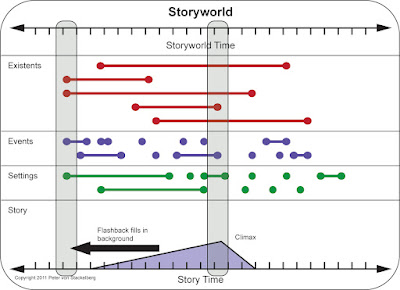A variety of story structures are possible with this storyworld framework. For example, Freytag’s Triangle (with or without flashbacks) (see Figure 1) can be represented with this storyworld framework. Selecting existents, events, and settings from some point in the story time’s past makes it possible to create flashbacks and flash forwards are created by taking elements from the future in story time. A vertical story structure in which a main storyline connects a series of threads that explore more deeply the states of particular characters, events, or settings at specific points in storyworld time can also be mapped out on a storyworld timeline.
Source: Peter von Stackelberg
Figure 1: A variety of story structures -- for example, Freytag's Triangle (with or without flashbacks and flash forwards) -- can be represented with this storyworld structure.
A storyworld timeline can be used to map out how different media are used to present a story in the storyworld. Moving horizontally along the timeline, for example, the main storyline could be created as a television program, while sub-plots or sub-stories are presented on a website/blog and in a comic book (see Figure 2).
Source: Peter von Stackelberg
Figure 2: A variety of media can be used for different stories or sub-stories, creating a transmedia narrative.
A detailed perspective on individual elements of the storyworld (e.g. a setting) could also be presented by moving horizontally along the timeline (see Figure 3). Working vertically on the timeline, it is possible to use a variety of media to create a series of “mini-stories” that can be linked to a main storyline or can stand on their own (see Figure 4).
Source: Peter von Stackelberg
Figure 3: Individual elements of the storyworld can be explored in detail -- "tourist guides" for fictional settings for example.
Source: Peter von Stackelberg
Figure 4: The storyworld can be expanded by using different media to provide more detail on different existents, events, and/or settings.
This flexibility in using the storyworld timeline approach makes it easy to map out interstitial micro stories (stories that are closely related to the main story), parallel story (stories that unfold at the same time and have a strong relationship to the main story), and peripheral stories (stories that have a weak relationship to and may not occur at the same time as the macro story). Interstitial, parallel, and peripheral stories have all been identified as ways in which storyworlds can be expanded (Scolari, 2009).




Wow! This is awesome. I love your info-graphics. I'm doing a blog series on transmedia storytelling. I'd love to ask you some questions. But I don't see anyway to get in touch with you. Hope you check your comments.
ReplyDelete